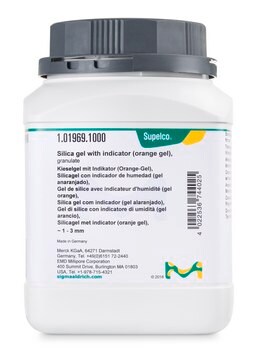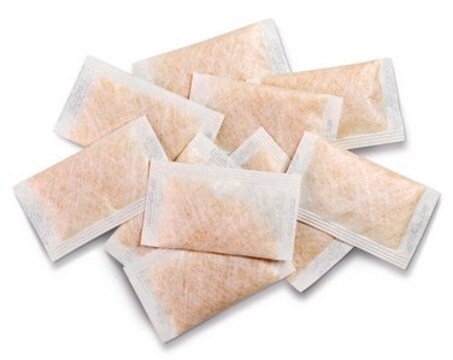1.01905
Gel de silice
granules, desiccant ~ 0.2 - 1 mm
About This Item
Produits recommandés
Niveau de qualité
Forme
granular
Puissance
>5000 mg/kg LD50, skin (Rabbit)
Superficie
700 m2/g
Perte
≤2.0% loss on drying, 180°C
Taille des particules
0.2-1 mm
Dimension de pores
2.0-2.5 nm
pH
7 (20 °C, 100 g/L in H2O, slurry)
pb
2230 °C
Pf
>1600 °C
Masse volumique apparente
200‑800 kg/m3
Température de stockage
15-25°C
Chaîne SMILES
O=[Si]=O
InChI
1S/O2Si/c1-3-2
Clé InChI
VYPSYNLAJGMNEJ-UHFFFAOYSA-N
Vous recherchez des produits similaires ? Visite Guide de comparaison des produits
Application
- Stability and Structure of Potentially Atmospherically Relevant Glycine Ammonium Bisulfate Clusters: This research examines the complex interactions and stability of atmospheric aerosols involving sulfuric acid, providing insights valuable for environmental scientists and chemists studying atmospheric chemistry and pollution mitigation strategies (Hariharan et al., 2024).
- Nanostructured Niobium and Titanium Carbonitrides as Electrocatalyst Supports: Discusses the role of sulfuric acid in synthesizing nanostructured materials for energy applications, relevant for material scientists and researchers in renewable energy technologies (McLeod et al., 2024).
- Synthesis and characterization of hydroxyapatite nanoparticles from calcium hydroxide fouled with gases evolved from the smokestack of the glass industry: Highlights the utility of sulfuric acid in the synthesis of nanoparticles for industrial applications, crucial for researchers in materials science and industrial manufacturing (Abdelmoaty and Mousa, 2024).
- Nucleophilic hydrolysis enables HF-etched MXene kilofarad specific capacitance and excellent rate performance: Demonstrates the application of sulfuric acid in enhancing the performance of electrochemical storage devices, relevant for material scientists working on advanced battery technologies (Xu et al., 2024).
Remarque sur l'analyse
Loss on drying (180 °C): ≤ 2.0 %
Water absorption capacity (24 hrs.,80 % relative humidity): ≥ 27.0 %
Code de la classe de stockage
13 - Non Combustible Solids
Classe de danger pour l'eau (WGK)
nwg
Point d'éclair (°F)
Not applicable
Point d'éclair (°C)
Not applicable
Certificats d'analyse (COA)
Recherchez un Certificats d'analyse (COA) en saisissant le numéro de lot du produit. Les numéros de lot figurent sur l'étiquette du produit après les mots "Lot" ou "Batch".
Déjà en possession de ce produit ?
Retrouvez la documentation relative aux produits que vous avez récemment achetés dans la Bibliothèque de documents.
Les clients ont également consulté
Notre équipe de scientifiques dispose d'une expérience dans tous les secteurs de la recherche, notamment en sciences de la vie, science des matériaux, synthèse chimique, chromatographie, analyse et dans de nombreux autres domaines..
Contacter notre Service technique



